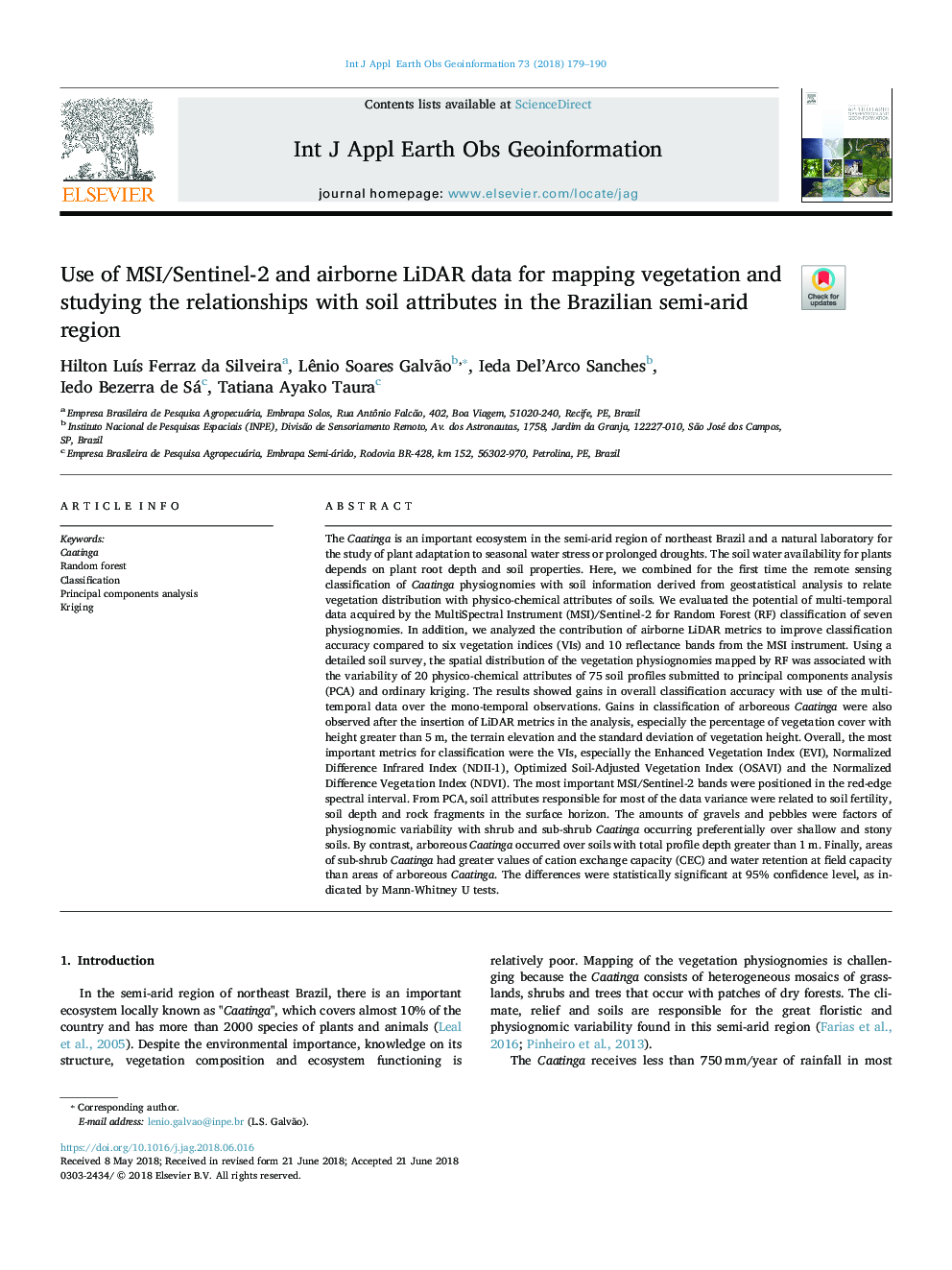| کد مقاله | کد نشریه | سال انتشار | مقاله انگلیسی | نسخه تمام متن |
|---|---|---|---|---|
| 8867722 | 1621784 | 2018 | 12 صفحه PDF | دانلود رایگان |
عنوان انگلیسی مقاله ISI
Use of MSI/Sentinel-2 and airborne LiDAR data for mapping vegetation and studying the relationships with soil attributes in the Brazilian semi-arid region
دانلود مقاله + سفارش ترجمه
دانلود مقاله ISI انگلیسی
رایگان برای ایرانیان
کلمات کلیدی
موضوعات مرتبط
مهندسی و علوم پایه
علوم زمین و سیارات
کامپیوتر در علوم زمین
پیش نمایش صفحه اول مقاله

چکیده انگلیسی
The Caatinga is an important ecosystem in the semi-arid region of northeast Brazil and a natural laboratory for the study of plant adaptation to seasonal water stress or prolonged droughts. The soil water availability for plants depends on plant root depth and soil properties. Here, we combined for the first time the remote sensing classification of Caatinga physiognomies with soil information derived from geostatistical analysis to relate vegetation distribution with physico-chemical attributes of soils. We evaluated the potential of multi-temporal data acquired by the MultiSpectral Instrument (MSI)/Sentinel-2 for Random Forest (RF) classification of seven physiognomies. In addition, we analyzed the contribution of airborne LiDAR metrics to improve classification accuracy compared to six vegetation indices (VIs) and 10 reflectance bands from the MSI instrument. Using a detailed soil survey, the spatial distribution of the vegetation physiognomies mapped by RF was associated with the variability of 20 physico-chemical attributes of 75 soil profiles submitted to principal components analysis (PCA) and ordinary kriging. The results showed gains in overall classification accuracy with use of the multi-temporal data over the mono-temporal observations. Gains in classification of arboreous Caatinga were also observed after the insertion of LiDAR metrics in the analysis, especially the percentage of vegetation cover with height greater than 5 m, the terrain elevation and the standard deviation of vegetation height. Overall, the most important metrics for classification were the VIs, especially the Enhanced Vegetation Index (EVI), Normalized Difference Infrared Index (NDII-1), Optimized Soil-Adjusted Vegetation Index (OSAVI) and the Normalized Difference Vegetation Index (NDVI). The most important MSI/Sentinel-2 bands were positioned in the red-edge spectral interval. From PCA, soil attributes responsible for most of the data variance were related to soil fertility, soil depth and rock fragments in the surface horizon. The amounts of gravels and pebbles were factors of physiognomic variability with shrub and sub-shrub Caatinga occurring preferentially over shallow and stony soils. By contrast, arboreous Caatinga occurred over soils with total profile depth greater than 1 m. Finally, areas of sub-shrub Caatinga had greater values of cation exchange capacity (CEC) and water retention at field capacity than areas of arboreous Caatinga. The differences were statistically significant at 95% confidence level, as indicated by Mann-Whitney U tests.
ناشر
Database: Elsevier - ScienceDirect (ساینس دایرکت)
Journal: International Journal of Applied Earth Observation and Geoinformation - Volume 73, December 2018, Pages 179-190
Journal: International Journal of Applied Earth Observation and Geoinformation - Volume 73, December 2018, Pages 179-190
نویسندگان
Hilton LuÃs Ferraz da Silveira, Lênio Soares Galvão, Ieda Del'Arco Sanches, Iedo Bezerra de Sá, Tatiana Ayako Taura,